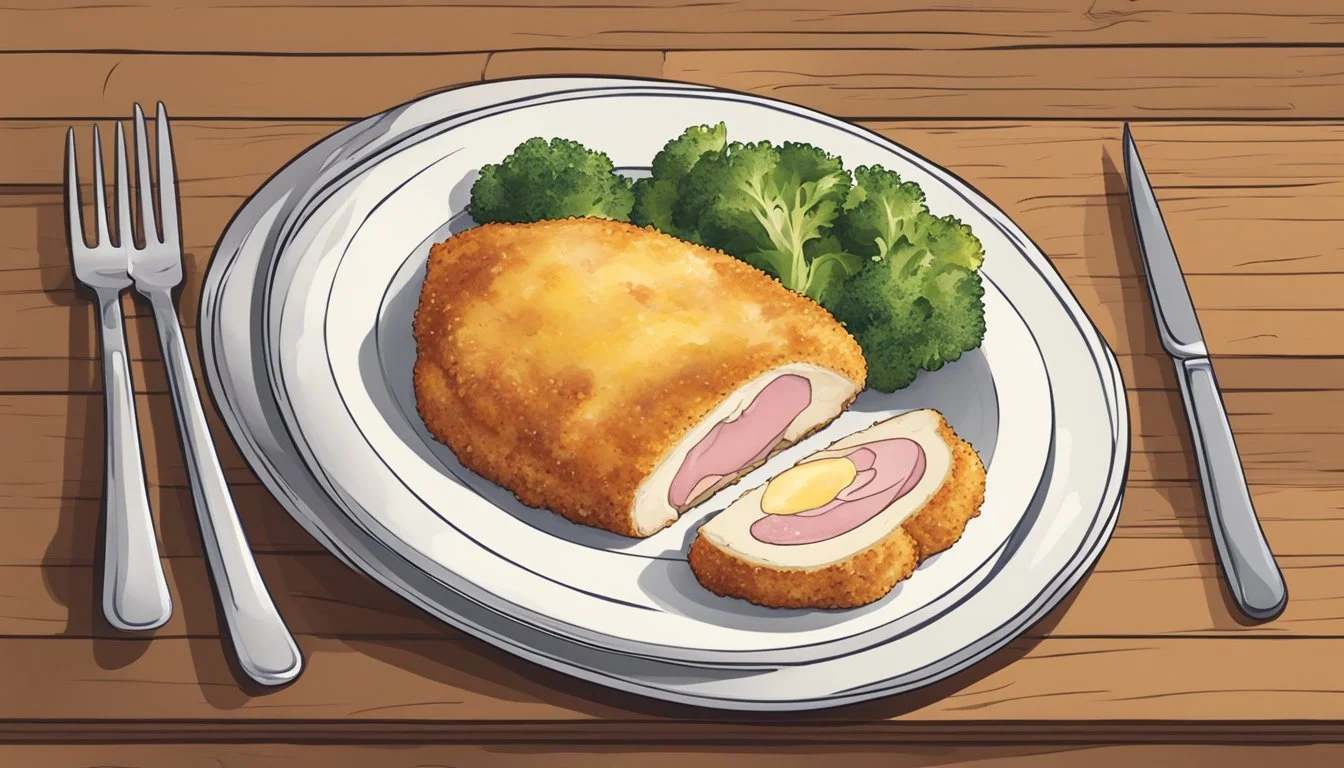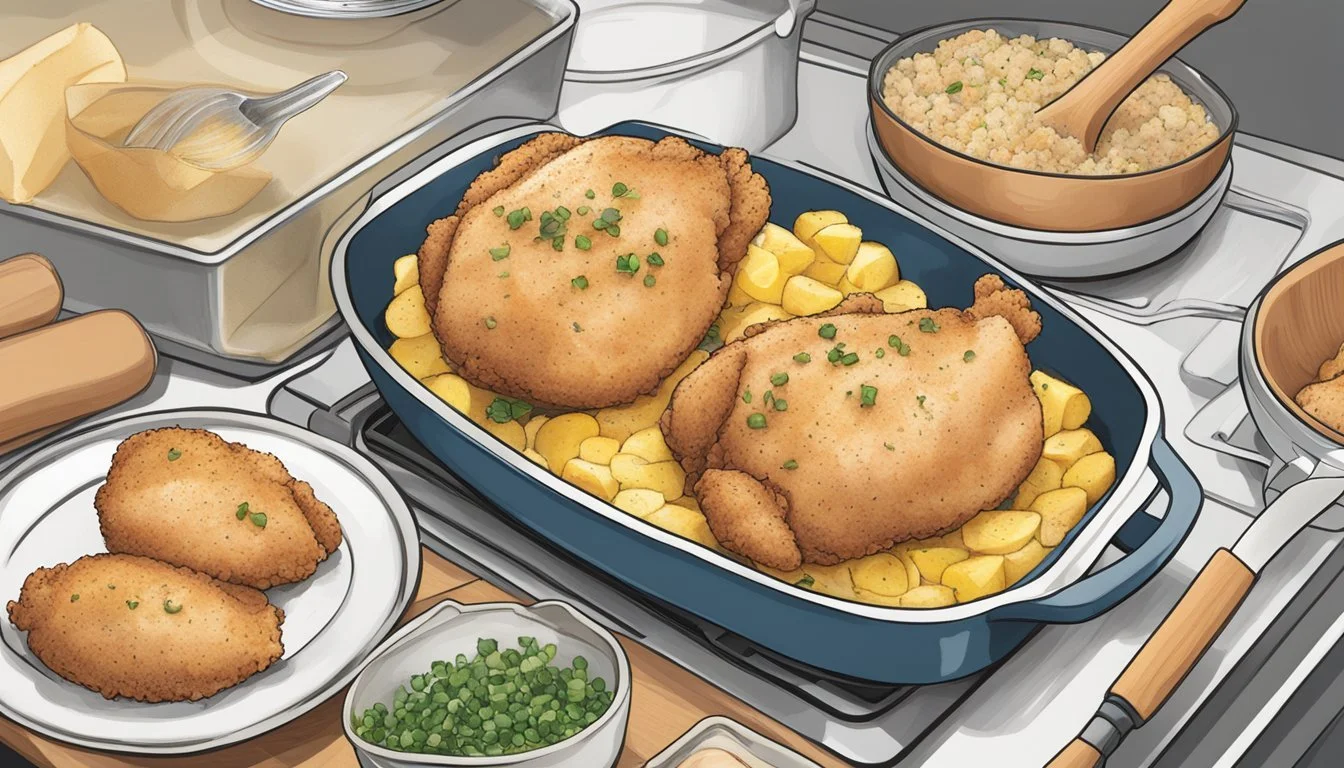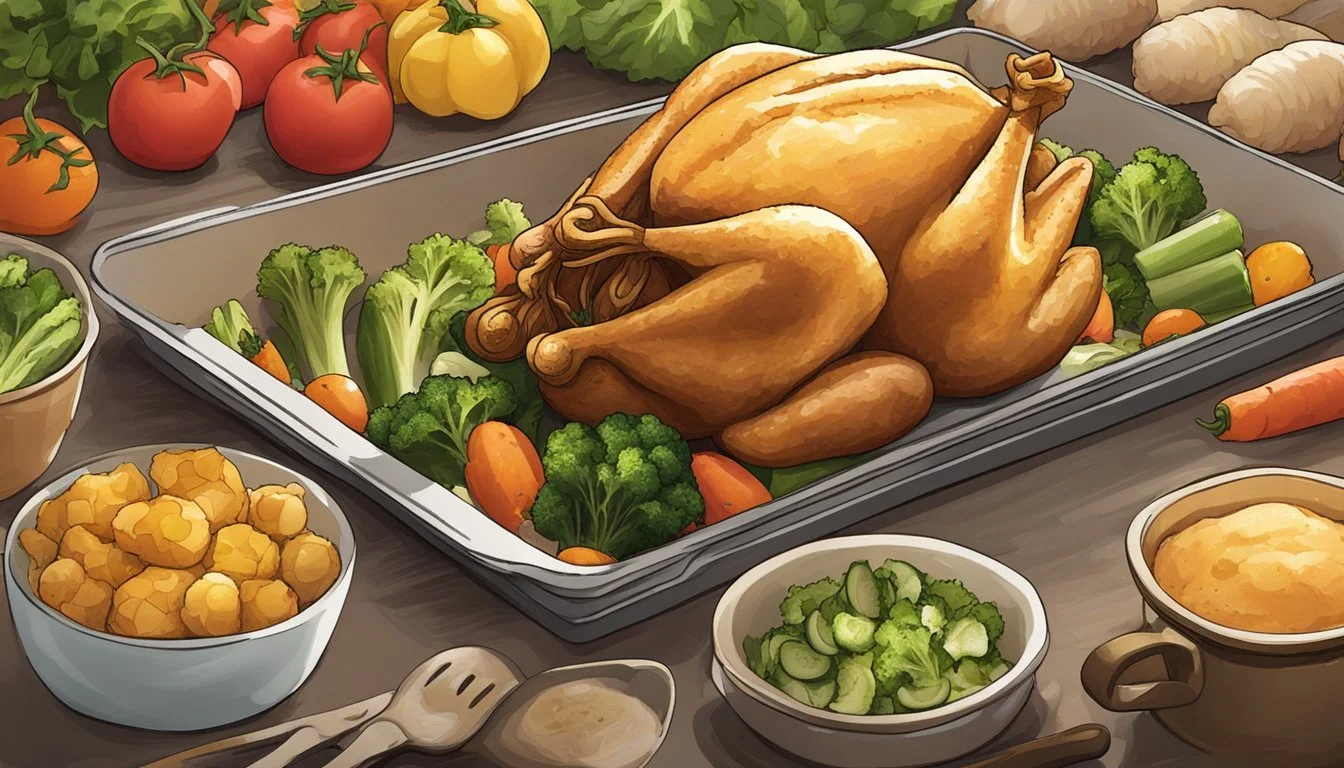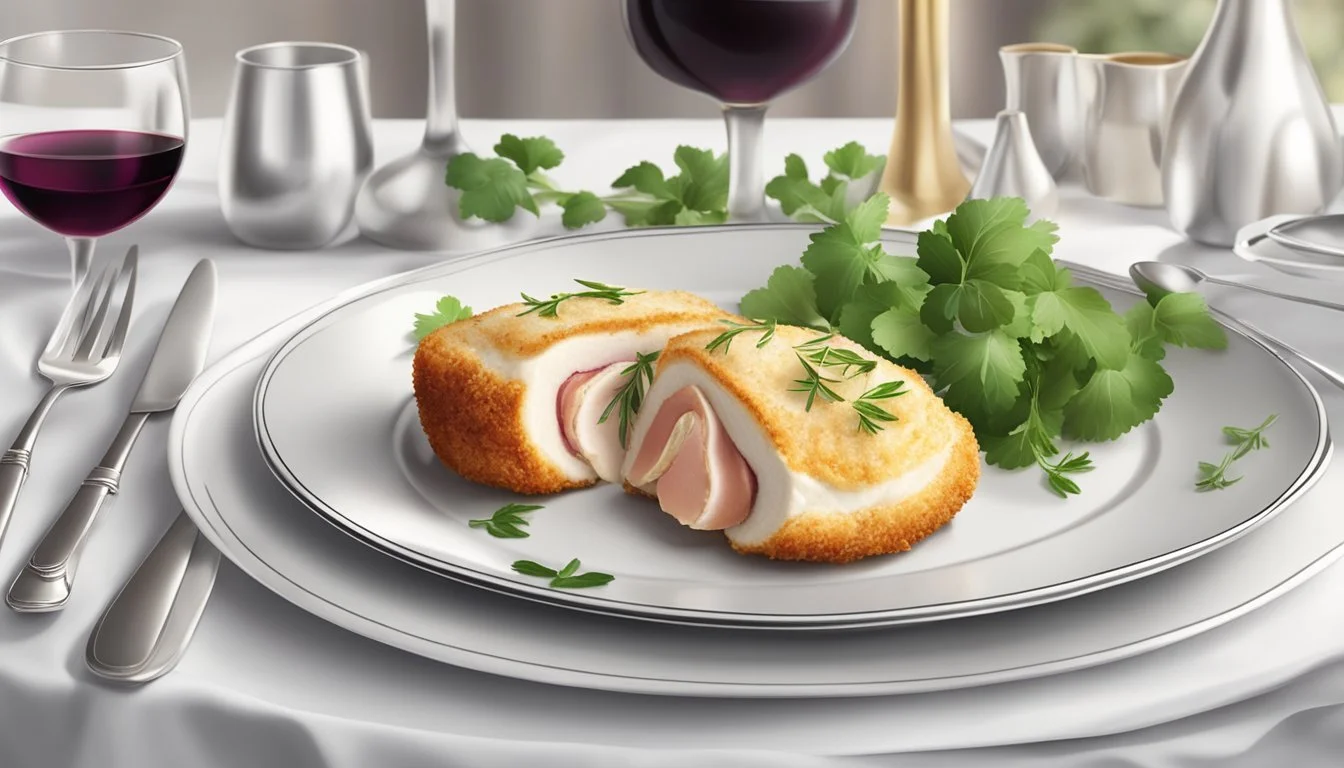How Long Does Chicken Cordon Bleu Last?
Storage Tips and Safety Guidelines
Chicken Cordon Bleu is a delightful dish combining tender chicken, savory ham, and melted Swiss cheese. Many wonder how long this classic dish can be safely stored. Properly stored, cooked Chicken Cordon Bleu lasts up to 3-4 days in the refrigerator.
Refrigeration is crucial to maintaining its quality. Leftovers should be placed in airtight containers or wrapped securely in aluminum foil or plastic wrap. When stored in the freezer, Chicken Cordon Bleu can be preserved for up to 2-3 months without a significant loss in flavor or texture.
To enjoy the same delicious taste, reheating the leftovers properly is essential. Achieving an internal temperature of 165°F ensures the dish is heated through while maintaining its delectable components.
Understanding Chicken Cordon Bleu
Chicken Cordon Bleu is a well-loved dish featuring chicken, ham, and cheese. This section will explore its origins, the essential ingredients, and popular variations, providing a comprehensive look at this classic dish.
Origins and Definition
Chicken Cordon Bleu is a dish with French roots but has gained worldwide popularity. The name "cordon bleu" translates to "blue ribbon," symbolizing a mark of excellence. Traditionally, it involves chicken breasts that are pounded thin, filled with ham and Swiss cheese, and then rolled up. The chicken is typically breaded and either baked or fried until golden and cooked through.
Key Ingredients
The fundamental components of this dish include chicken breast, ham, and Swiss cheese. A typical preparation involves spreading a layer of dijon mustard over the ham and cheese before rolling the chicken. Breadcrumbs and eggs are used for breading. Optional ingredients often include butter and seasonings like salt, pepper, and garlic powder to enhance flavor.
Popular Variations
There are many ways to vary Chicken Cordon Bleu. Some recipes substitute prosciutto for ham or Gruyère for Swiss cheese. Vegetarian versions swap chicken with eggplant or zucchini. Additionally, modern recipes may use an air fryer instead of traditional frying or baking methods, offering a healthier alternative. Various sauces, such as Dijon cream sauce, are also popular accompaniments to this classic dish.
Preparing Chicken Cordon Bleu
In this section, the preparation process for Chicken Cordon Bleu will be covered in detail, including the ingredients, the breading and assembly, and various cooking methods.
Ingredient Breakdown
To start, it's essential to gather quality ingredients. Chicken breasts are the primary component; they should be tender and of medium thickness. You will also need deli ham slices, preferably prosciutto or the classic thin-sliced ham.
Cheese varieties such as Swiss or provolone work well, providing the signature creamy texture. Salt and pepper are essential for seasoning. For the breading, you will need flour, beaten eggs (or an egg wash with a bit of milk), and breadcrumbs. For an extra crispy result, use a mix of panko and grated Parmesan cheese. Lastly, a bit of Dijon mustard can add a tangy flavor to the dish.
Breading and Assembly
Begin by placing the chicken breasts between two pieces of plastic wrap on a cutting board and using a mallet to pound them to about ¼-inch thick. Season the chicken with salt and pepper. Lay a slice of ham and cheese on each flattened chicken breast, then roll them into tight bundles.
Secure the rolls with toothpicks if needed. To prepare the breading, first coat the chicken rolls in flour, shaking off any excess. Dip them in the beaten eggs or egg wash, followed by rolling them in the breadcrumb mixture. Ensure they are fully coated for an even crust.
Cooking Methods
There are various methods to cook Chicken Cordon Bleu. Baking is a popular choice; preheat the oven to 375°F (190°C). Place the chicken rolls on a baking sheet lined with parchment paper and cook for approximately 25-30 minutes, or until the internal temperature reaches 165°F (74°C).
For a quicker method, use an air fryer. Preheat it to 400°F (204°C), place the rolls in the basket, and cook for 15-20 minutes. Ensure even cooking by spraying tops with nonstick cooking spray or olive oil spray. For those preferring a stovetop method, sauté the rolls in butter over medium heat until golden brown and cooked through.
Baking and Cooking Considerations
Understanding the techniques and key parameters involved in baking and cooking Chicken Cordon Bleu ensures optimal results, balancing flavor and texture. Critical factors include cooking methods, checking internal temperatures, and proper timing.
Oven Baking
Oven baking provides even heat distribution, yielding uniformly cooked Chicken Cordon Bleu. Preheat the oven to 375°F (190°C) for consistent results. Place the stuffed chicken breasts on a baking sheet lined with aluminum foil to prevent sticking and facilitate cleanup.
Bake for approximately 25-30 minutes, depending on chicken thickness. An instant-read thermometer is essential; the internal temperature should reach 165°F to ensure safe consumption. Panko breadcrumbs can be used for a crispy exterior.
Pan Frying Techniques
Pan frying Chicken Cordon Bleu yields a crispy exterior and juicy interior. Heat a sufficient amount of oil in a skillet over medium-high heat. Carefully place the breaded chicken breasts into the pan.
Fry each side for about 7-10 minutes until golden brown, ensuring thorough cooking while avoiding burning. Use an instant-read thermometer to ensure the internal temperature hits 165°F. Pan frying is quicker but requires attentive monitoring to prevent uneven cooking.
Alternative Cooking Methods
Alternative methods such as air frying can provide a healthier option while maintaining texture. Preheat the air fryer to 375°F (190°C). Place the Chicken Cordon Bleu in the basket, ensuring they're not overcrowded.
Cook for about 15-20 minutes, shaking the basket halfway through. Deep-frying involves submerging the chicken in hot oil at 350°F (175°C) for about 5-7 minutes until crisp and golden. Both methods require verifying the internal temperature with an instant-read thermometer for safety.
Serving and Presentation
When serving Chicken Cordon Bleu, attention to accompaniments and plating is essential for an impressive and satisfying meal. Selecting the right sides and presenting each element appealingly can elevate the dining experience.
Accompaniments
A harmonious combination of side dishes enhances the flavors of Chicken Cordon Bleu. Mashed potatoes or roasted potatoes offer a comforting, creamy contrast to the crispy chicken. Steamed green beans or blanched broccoli add a fresh, vibrant touch and balance the richness of the dish.
A flavorful Dijon cream sauce pairs beautifully, complementing the ham and cheese filling. Made with heavy cream, Dijon mustard, and a touch of white wine, this sauce adds depth. Thyme and kosher salt can be used to season both the chicken and the sauce for a cohesive taste profile.
Plating Tips
Effective plating starts with a clean, white plate to make the colors pop. Place the Chicken Cordon Bleu in the center. Arrange mashed potatoes and green beans or broccoli around it for balance. Drizzle a cream sauce over the chicken, allowing a bit to pool on the plate.
For added texture and flavor, garnish with a sprinkle of bread crumbs toasted in melted butter. Finish with a few fresh thyme leaves to add an aromatic element to the presentation. Remember to keep portions reasonable, avoiding overcrowding the plate to ensure a visually appealing and appetizing dish.
Storage and Shelf Life
Proper storage of chicken cordon bleu can significantly extend its shelf life. Whether refrigerated or frozen, adhering to appropriate storage methods ensures safety and quality.
Refrigeration
When stored in the refrigerator at a temperature between 32°F and 40°F, cooked chicken cordon bleu remains safe to consume for up to 3-4 days. It is crucial to place the chicken in an airtight container or wrap it tightly with plastic wrap to prevent moisture loss and contamination.
Uncooked chicken cordon bleu can be stored in the refrigerator for up to 2 days. Wrapping it tightly in plastic wrap or aluminum foil helps maintain its moisture and prevents it from absorbing odors from other foods.
Leftovers should be reheated thoroughly before consumption. Preferably, use a skillet over medium heat with a small amount of oil or butter, covering with a lid to retain moisture.
Freezing and Thawing
For long-term storage, freezing chicken cordon bleu is an effective method. Properly wrapped uncooked chicken cordon bleu can last up to 3 months in the freezer. To prevent freezer burn, double-wrap each piece tightly in plastic wrap and place them in a freezer-safe bag.
Frozen cooked chicken cordon bleu should be consumed within 1-2 months for optimal taste and texture. For reheating, it should be thawed in the refrigerator overnight and then heated in an oven or skillet.
Thawing in the refrigerator is the safest technique, as it keeps the chicken at a stable, safe temperature. Rapid thawing methods, such as using a microwave, should be avoided to maintain the quality of the chicken.
By following these storage guidelines, chicken cordon bleu can be enjoyed safely with its flavors and textures well preserved.
Healthy and Dietary Considerations
When making Chicken Cordon Bleu, several adjustments can be made to enhance its nutritional value and cater to specific dietary needs. These adaptations can significantly reduce calories and make the dish accessible to gluten-free diets.
Lower Calorie Options
Reducing the calorie content of Chicken Cordon Bleu involves making several ingredient substitutions. Swiss cheese can be replaced with a low-fat or reduced-fat version. Choosing prosciutto over traditional ham also helps reduce calories.
Using an air fryer instead of a deep fryer allows for a healthier cooking method while maintaining the crispy exterior. Spraying a small amount of cooking oil ensures the breadcrumbs cling to the chicken without adding excessive calories. Baking the chicken at 450°F is another excellent alternative to frying.
Combining these adjustments, the overall calorie intake can be reduced while still enjoying a comforting meal. Be mindful of portion sizes and avoid excessive amounts of high-calorie ingredients.
Gluten-Free Adaptations
For those adhering to a gluten-free diet, substituting all-purpose flour and seasoned breadcrumbs with gluten-free alternatives is essential. Use gluten-free flour blends that offer similar texture and binding properties as traditional flour.
Gluten-free breadcrumbs are readily available and can be seasoned at home for enhanced flavor. Ground almonds or crushed gluten-free crackers are also effective substitutes.
Ensure all other ingredients, such as meats and cheeses, are verified gluten-free. Combining these substitutions helps maintain the integrity of the dish while making it suitable for individuals with gluten sensitivities or celiac disease.
Proper preparation and ingredient selection are key to a successful gluten-free Chicken Cordon Bleu.
Troubleshooting Common Issues
When preparing Chicken Cordon Bleu, home cooks often encounter issues such as soggy breading, undercooked chicken, or cheese leaking out from the pockets. These common pitfalls can be addressed with some targeted troubleshooting techniques.
Avoiding Soggy Breading
Soggy breading can ruin the texture. To keep it crispy, start by drying the chicken breasts thoroughly with paper towels. Then, coat the chicken evenly with flour, egg, and breadcrumbs in that order.
Baking on a wire rack on a sheet pan allows heat to circulate, avoiding moisture accumulation on one side. Incorporate dried thyme into the breadcrumbs for an extra layer of flavor.
Ensuring Chicken is Cooked Thoroughly
Undercooked chicken poses health risks. To ensure thorough cooking, flatten the chicken breasts to uniform thickness using a meat mallet. Cooking times vary by thickness but generally range from 25-30 minutes at 375°F.
Always verify the internal temperature with a meat thermometer, aiming for 165°F at the center of the chicken. This step ensures safety and perfect doneness.
Preventing Cheese Leakage
Cheese leaking from the pockets can leave the chicken dry and the dish less appealing. To prevent this, secure the edges of the chicken well with toothpicks. Lay the sliced ham and cheese within the center, folding the chicken over to create a sealed pocket.
For extra protection, try double-wrapping the chicken, first with a layer of ham, then cheese, followed by a second layer of ham. This method helps contain the cheese and keeps it from oozing out during cooking.









